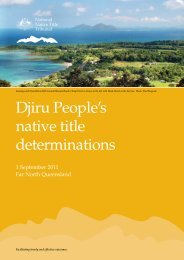Biodiveristy_State of Environment report - Mission Beach Cassowaries
Biodiveristy_State of Environment report - Mission Beach Cassowaries
Biodiveristy_State of Environment report - Mission Beach Cassowaries
- No tags were found...
Create successful ePaper yourself
Turn your PDF publications into a flip-book with our unique Google optimized e-Paper software.
not survive.This makes available habitat the key issue in determiningcassowary numbers. Further reductions in habitat are asignificant hazard to the viability <strong>of</strong> the cassowarypopulation.It is likely that the shape and connectivity <strong>of</strong> habitat will alsodetermine whether cassowaries can successfully utilise it asa territory. Both the extent and structure <strong>of</strong> habitat remainingis under threat from development.Dry seasons in the rainforest or cyclone events can alsoadversely affect cassowaries, when their available foodsources from fruit are reduced.<strong>Cassowaries</strong> are also affected by disease. It is known thatsome birds have respiratory diseases. Some birds can survivethis, but then pass the disease on. An example is one malebird at <strong>Mission</strong> <strong>Beach</strong> known to raise a chick each year thatsubsequently succumbs to the disease before reachingmaturity. Further research is required into the cassowarydiseases.ConditionCassowary numbers are not known. QPWS have positivelyidentified 25 known birds in the region. C4 estimate anumber <strong>of</strong> approximately 40 adult birds in the <strong>Mission</strong><strong>Beach</strong> area.Studies carried out in 1992-1998 in the Daintree regiondetermined that most cassowaries maintain a home range <strong>of</strong>1-3 km 2 (Moore and Moore, 1998). Similar densitiesoccurred at <strong>Mission</strong> <strong>Beach</strong>. Moore and Moore (1998)estimated a population <strong>of</strong> 76-81 adult birds in the <strong>Mission</strong><strong>Beach</strong> area, from coast through to hinterland, based onsurvey work and previous studies. They note that habitatclearing has reduced this population from previous levelsdetermined by Bentrupperbaumer (1992).Whilst there are large natural areas around <strong>Mission</strong> <strong>Beach</strong>,the cassowaries do not utilise the parts that are steeplysloped mountainous areas (Allanson, pers comm.). They relyupon a reasonable grade <strong>of</strong> land, and the types <strong>of</strong> foodbearinghabitat on these areas. They are primarily a coastalspecies.A program is under development by the EPA ThreatenedSpecies Unit to monitor the population by sampling DNAfrom cassowary droppings. Unfortunately, some problemshave so far held this program back; as a number <strong>of</strong> rainforestfruits in the bird's diet contain chemicals that degrade theDNA samples.There is speculation by QPWS that a lack <strong>of</strong> geneticexchange may be affecting some portions <strong>of</strong> the cassowarypopulation. Some birds at Etty Bay are showing reducedwattle size, which could be an effect due to inbreeding.However, without genetic sampling over the regionalpopulation it is not possible to determine whether inbreedingis occurring.C4 record the number <strong>of</strong> sightings <strong>report</strong>ed, mainly bytourists, <strong>of</strong> cassowaries in the <strong>Mission</strong> <strong>Beach</strong> area. Thedifficulty in interpreting this information is that it does notrepresent actual numbers, and may be a better indicator <strong>of</strong>visitor interest. However, the sightings are important in thatthey provide an early warning system - significant drops inCassowary - Casuarius casuarius johnsoniiTable 2.3.3a - Cassowary Sightings Source: C4 (2005)Note that Sightings will depend on the response fromtourists and locals and will vary according to visitornumbers or community interest.Recorded CassowarySightings—<strong>Mission</strong> <strong>Beach</strong>2001 2002 2003 2004Adult Males positivelyidentified (i.e. with chicks)nd 193 118 81Adults (unidentified sex) 246 188 214 136Sub adults 112 137 124 68Chicks 97 264 89 111Total 455 782 545 396the number sighted will be cause for concern.Because the cassowary population is dependent on availableterritory this is a better descriptor <strong>of</strong> the likely numbers <strong>of</strong>birds. A slightly greater number exists than the availablehabitat can support, due to unnatural food sources. Thisincludes waste fruit at banana plantations or orchards. Thismeans there are some fringe-dwelling cassowaries that donot have established territories. These birds won't breedsuccessfully, but do form a reserve in the case <strong>of</strong> mortality<strong>of</strong> established birds.QPWS record cassowary deaths in the <strong>Mission</strong> <strong>Beach</strong> area.Not all incidents are recorded, as birds involved in vehiclecollisions and dog attacks usually enter the rainforest, wherethey eventually succumb to their injuries out <strong>of</strong> sight.A total <strong>of</strong> 14 birds were <strong>report</strong>ed killed in 2004 in the<strong>Mission</strong> <strong>Beach</strong> area (Allanson, pers comm.), mostly fromroad deaths. No dog attacks were <strong>report</strong>ed during the year.It is likely that increased public awareness <strong>of</strong> the birds hasraised the number <strong>of</strong> deaths being <strong>report</strong>ed (Allanson pers.comm). Table 2.3.3b describes cassowary deaths recordedsince 1993 by C4. These are mostly motor vehicle deathsand dog attacks, but also include deaths from malnutrition,which possibly indicate difficulties with successfulSource: C453



